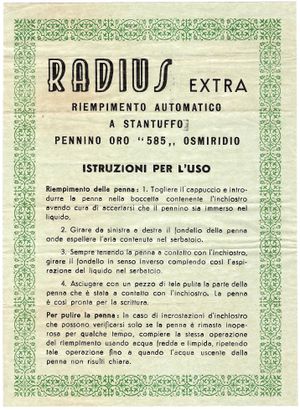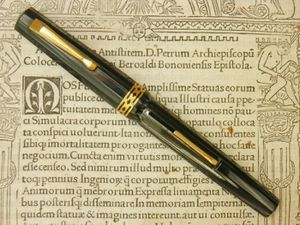Differenze tra le versioni di "Radius/en"
| (16 versioni intermedie di 2 utenti non mostrate) | |||
| Riga 1: | Riga 1: | ||
<noinclude>[[File:Radius-Logo.svg|center|300px|Logo Radius]] The [[Radius]] brand is the one which is known for the highest quality [[SAFIS]] production, and is usually identified with this company. It was joined by the [[Astura]] brand, used for the second tier production. Though less known, it is the production of one of the most important Italian companies, and [[Radius]] pens, like its predecessors [[The King]], are, at least for the production that took place in the golden age of company, of highest quality and have nothing to envy to the production of the most famous italian companies like [[OMAS]] or [[Aurora]]. | <noinclude>[[File:Radius-Logo.svg|center|300px|Logo Radius]] The [[Radius]] brand is the one which is known for the highest quality [[SAFIS]] production, and is usually identified with this company. It was joined by the [[Astura]] brand, used for the second tier production. Though less known, it is the production of one of the most important Italian companies, and [[Radius]] pens, like its predecessors [[The King]], are, at least for the production that took place in the golden age of company, of highest quality and have nothing to envy to the production of the most famous italian companies like [[OMAS]] or [[Aurora]]. | ||
| − | With the competition due to the gradual spread of the ballpoint pen on the market, the quality of the production, especially in the last years of the company, got much worse, but after the war, the [[Radius]] has continued to produce good quality celluloid pens until the '50s, and the production of this brand is still of great interest collezionistico.{{Infobox_Brand|Radius}} | + | With the competition due to the gradual spread of the ballpoint pen on the market, the quality of the production, especially in the last years of the company, got much worse, but after the war, the [[Radius]] has continued to produce good quality celluloid pens until the '50s, and the production of this brand is still of great interest collezionistico.{{Infobox_Brand|Radius}}{{BrandData|Place=Torino|Country=IT|MainBrand=SAFIS|Fullname=Società Anonima Fabbrica Italiana Stilografiche}} |
== History == | == History == | ||
| − | |||
| − | |||
[[Image:Radius-Extra-Piston-Instr.jpg|thumb|A '50s [[Radius Extra]] instruction sheet.]] | [[Image:Radius-Extra-Piston-Instr.jpg|thumb|A '50s [[Radius Extra]] instruction sheet.]] | ||
| − | + | </noinclude>Around [[1934]] ''"The King Società Anonima Torino"'' was renamed in ''"Società Anonima Fabbrica Italiana Stilografiche"'', because of the policies of forced Italianisation of names carried out by the fascist regime,<noinclude><ref>Letizia Jacopini in his book ''La storia della stilografica in Italia'', reports the testimony of Bruno Milocani and Emilio Pionzo indicating the shift of production from [[The King]] to [[Radius]] around [[1935]] right for this reason.</ref></noinclude> which made it unattractive to use an English name. It is not known when the first pens [[Radius]] appeared on the market, and at the moment the only certain date is that of the trade mark registration ({{Marchio|50489}}) which occurred in [[1934]] by the new company, which is why we take this year as its starting date. | |
[[File:Radius-Superior-Faceted-Lever-Big-StriatedGray-Capped.jpg|thumb|left|A [[Radius Superior]]]] | [[File:Radius-Superior-Faceted-Lever-Big-StriatedGray-Capped.jpg|thumb|left|A [[Radius Superior]]]] | ||
| − | [[ | + | The [[Radius]] initial production was divided in two lines: the [[Radius Superior|Superior]] for the more valuable high-end pens and more valuable, and the [[Radius Extra|Extra]] for second tier pens sold at lower prices. The [[Radius Superior|Superior]] line remained in production, with different stylistic and technical changes, including the implementation of [[Radius Superior Trasparente|Trasparente]] version, until the '50s, while the [[Radius Extra|Extra]] line was decommissioned in the late '40s, replaced by other economic production, such as the [[Comet]] and the [[Radius 31]], [[hooded nib]] models of much lower quality than its predecessors. |
| − | + | In the '50s in fact (at least so it appears in [[:Category:Catalogo-Tentardini-195x|this catalog]]) the [[Radius Superior|Superior]] line, which in the meantime had taken on ogival lines following the stylistic trends of the period, was flanked by cheaper models such as the [[Comet]] (with a winged nib very similar to that of the [[Montblanc 25x]]) and the [[Radius 31]], a model with [[hooded nib]] of much lower quality than its predecessors. In the same catalog we note the presence of an additional model, the [[Fortune 38]], a clear imitation of the [[Pelikan 400]].<noinclude> | |
| − | [[ | + | There is no known date of termination of production under the [[Radius]] brand, but it is placed in the second half of the '50s (but certainly later than [[1956]], appearing [[SAFIS]] in [[:File:1956-Annuario-General-Industria-Stilografiche-A.jpg|this yearbook]] of that year) considering it concomitant with the cessation of activities of the parent company, which was probably put out of business by the success of ballpoint pens. However, there are no reliable documents or precise indications about the cessation of activities.<noinclude> |
{{BrandChrono|Radius}} | {{BrandChrono|Radius}} | ||
==External references== | ==External references== | ||
| − | * http://www.pentrace.net/article112900028.html | + | * [https://web.archive.org/web/20101127234410/http://www.pentrace.net/article112900028.html] Article on PenTrace |
| − | * | + | * [https://web.archive.org/web/20050125011331/http://www.fortunecity.it/lunapark/eventi/71/w12.html] Article, first part |
| − | * | + | * [https://web.archive.org/web/20011122230744/http://www.fortunecity.it/lunapark/eventi/71/w13.html] Article, second part |
==Notes== | ==Notes== | ||
<references/> | <references/> | ||
Versione attuale delle 01:07, 31 gen 2022
The Radius brand is the one which is known for the highest quality SAFIS production, and is usually identified with this company. It was joined by the Astura brand, used for the second tier production. Though less known, it is the production of one of the most important Italian companies, and Radius pens, like its predecessors The King, are, at least for the production that took place in the golden age of company, of highest quality and have nothing to envy to the production of the most famous italian companies like OMAS or Aurora.
With the competition due to the gradual spread of the ballpoint pen on the market, the quality of the production, especially in the last years of the company, got much worse, but after the war, the Radius has continued to produce good quality celluloid pens until the '50s, and the production of this brand is still of great interest collezionistico.
| Radius |
|---|
| Brand pages |
| Brand advertising |
| Brand photos |
| Instructions sheet |
History

Around 1934 "The King Società Anonima Torino" was renamed in "Società Anonima Fabbrica Italiana Stilografiche", because of the policies of forced Italianisation of names carried out by the fascist regime,[1] which made it unattractive to use an English name. It is not known when the first pens Radius appeared on the market, and at the moment the only certain date is that of the trade mark registration (Reg. Gen. N. 50489) which occurred in 1934 by the new company, which is why we take this year as its starting date.
The Radius initial production was divided in two lines: the Superior for the more valuable high-end pens and more valuable, and the Extra for second tier pens sold at lower prices. The Superior line remained in production, with different stylistic and technical changes, including the implementation of Trasparente version, until the '50s, while the Extra line was decommissioned in the late '40s, replaced by other economic production, such as the Comet and the Radius 31, hooded nib models of much lower quality than its predecessors.
In the '50s in fact (at least so it appears in this catalog) the Superior line, which in the meantime had taken on ogival lines following the stylistic trends of the period, was flanked by cheaper models such as the Comet (with a winged nib very similar to that of the Montblanc 25x) and the Radius 31, a model with hooded nib of much lower quality than its predecessors. In the same catalog we note the presence of an additional model, the Fortune 38, a clear imitation of the Pelikan 400.
There is no known date of termination of production under the Radius brand, but it is placed in the second half of the '50s (but certainly later than 1956, appearing SAFIS in this yearbook of that year) considering it concomitant with the cessation of activities of the parent company, which was probably put out of business by the success of ballpoint pens. However, there are no reliable documents or precise indications about the cessation of activities.
Chronology
| Year | Event |
|---|---|
| 1934 | SAFIS register the Radius trademark (Reg. Gen. N. 50489) |
| 1935 | the company introduces the Radius Extra (guess date, stands for the mid '30s) |
| 1941 | the company introduces the Radius Extra Trasparente (guess date, stands for the beginning of '40s) |
| 1941 | the company introduces the Radius Superior Trasparente (guess date, stands for the beginning of '40s) |
External references
Notes

